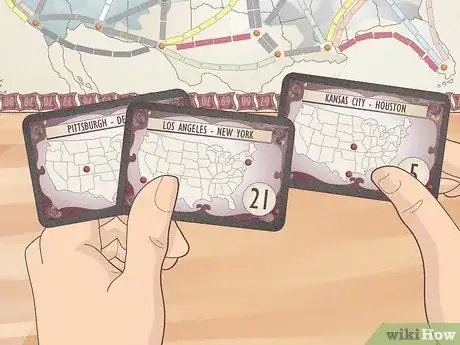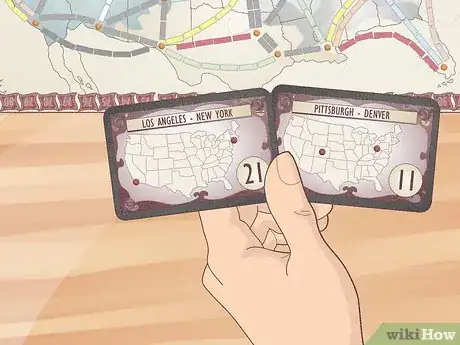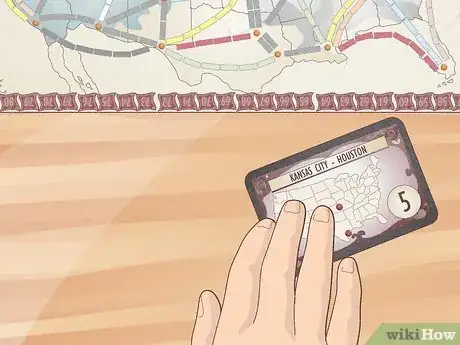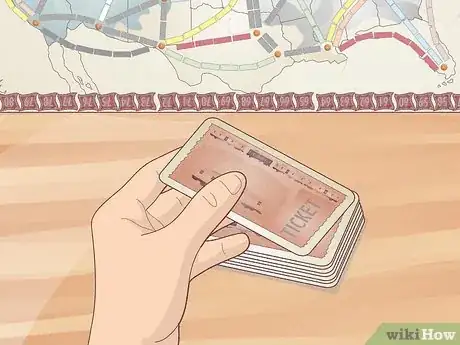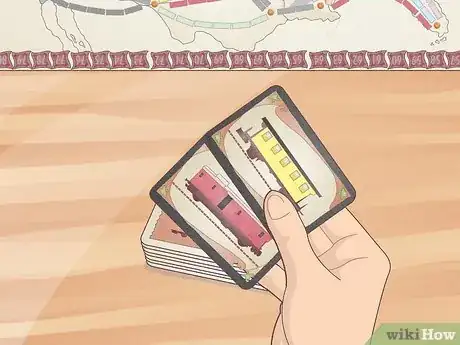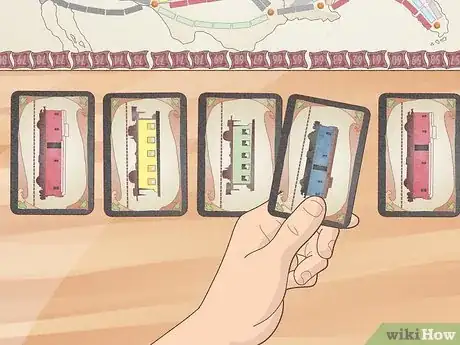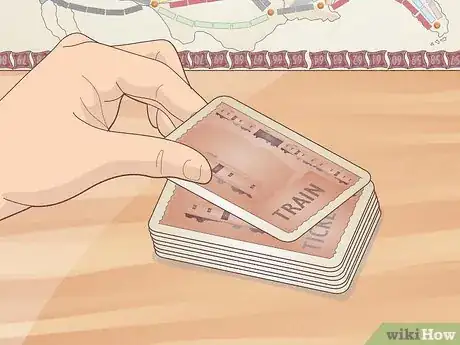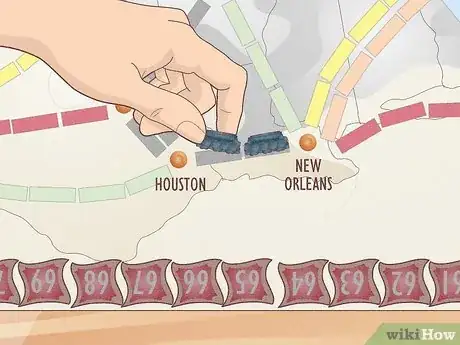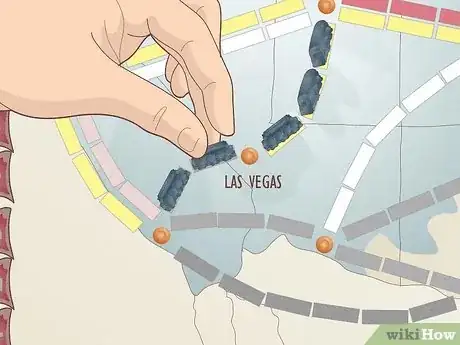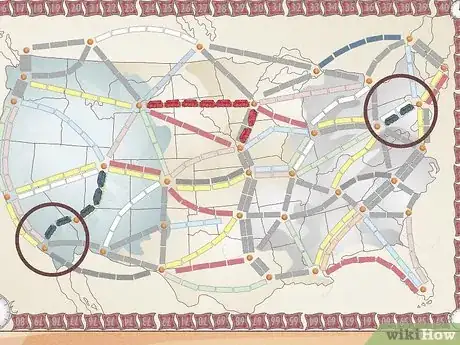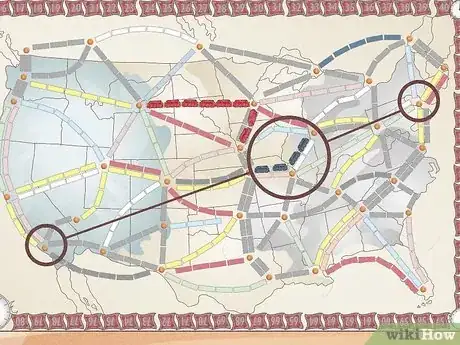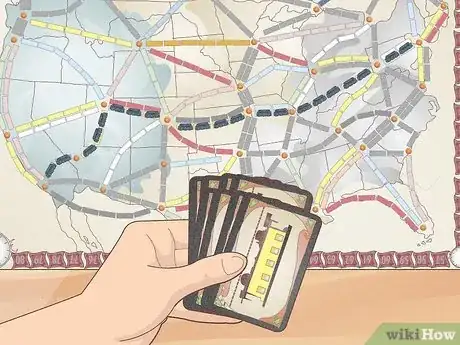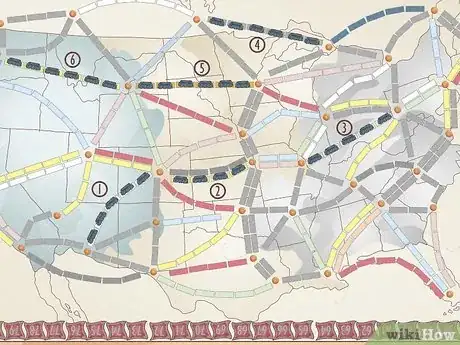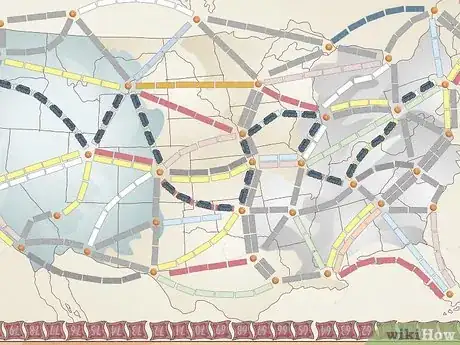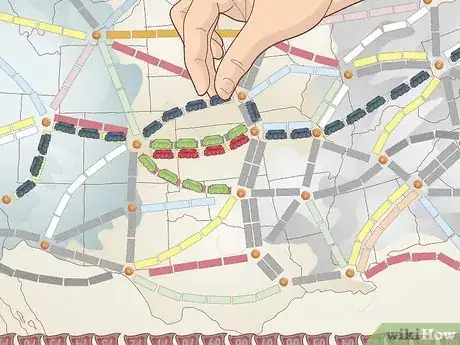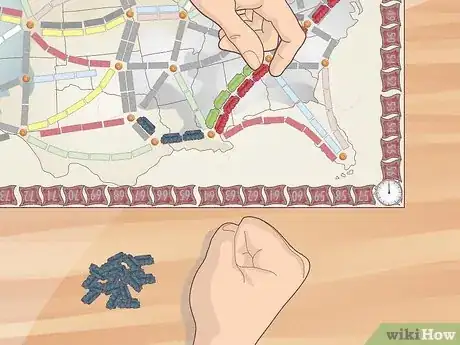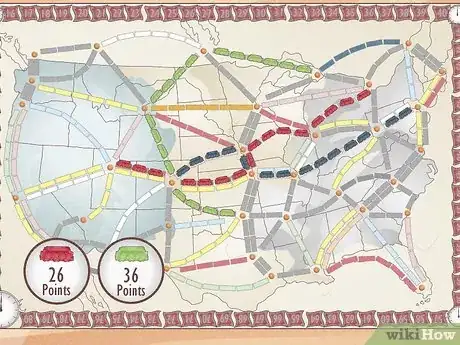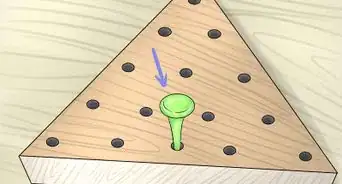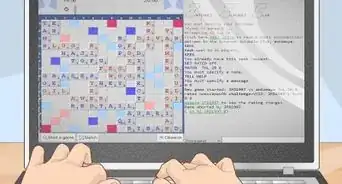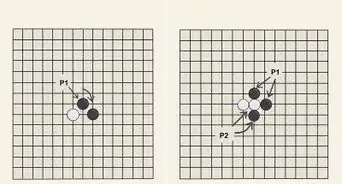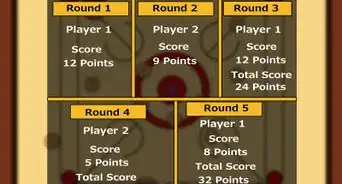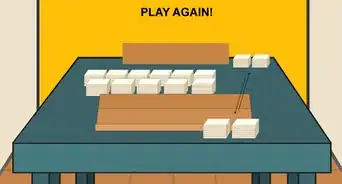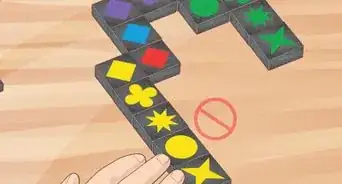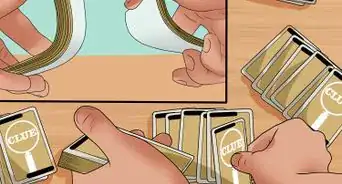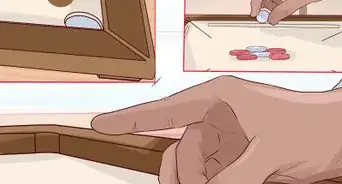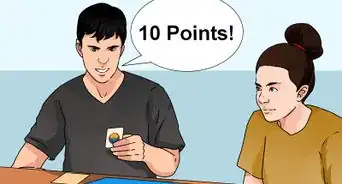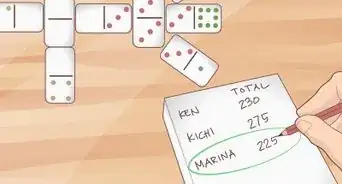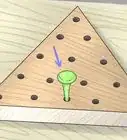This article was co-authored by wikiHow staff writer, Glenn Carreau. Glenn Carreau is a wikiHow Staff Writer, currently based in Los Angeles. With over four years of experience writing for several online publications, she has covered topics ranging from world history to the entertainment industry. Glenn graduated with honors from Columbia College Chicago, earning a B.A. in Interactive Arts and Media and a minor in Professional Writing. Today, Glenn continues to feed her lifelong love of learning while serving wikiHow's many readers.
This article has been viewed 3,609 times.
Learn more...
Looking to become a master of playing Ticket to Ride? This popular board game combines strategy with the luck of the draw—but luckily, there are plenty of ways to win. If you want to learn how to strategize and develop a strong, hard-to-beat game plan, you’ve come to the right place! Read on for a comprehensive guide to all the best Ticket to Ride gameplay strategies, so you can start winning games and surprising your fellow players!
Things You Should Know
- Build a long, high-value train route and pick up several smaller ticket routes that connect or are part of the longer one.
- Spend a few rounds collecting nothing but train cards. Then, when you have a wide variety collected, you can claim whole routes at a time.
- Draw from the facedown pile whenever possible and play trains in different spaces across the board to hide your intentions from other players.
- Grab several new tickets towards the end of the game to try and get some last-minute routes completed.
Steps
Choosing Tickets & Routes
-
1Look up the routes so you know the ones that are worth more points. Ticket to Ride has 30 possible train routes to develop, but some offer more points for completion than others. Start learning the most pointy-heavy routes; this helps you pick the best ones for yourself and identify when other players are trying to score major points through a big route.[1]
- The highest-scoring routes are Seattle to New York (22 points), Los Angeles to New York (21 points), Los Angeles to Miami (20 points), and Vancouver to Montreal (20 points).
- The next-highest routes after that are Portland to Nashville (17 points), San Francisco to Atlanta (17 points), and Los Angeles to Chicago (16 points).
- Pay special attention to the routes leading into New York and Los Angeles since there are multiple tickets that begin and end there.
-
2Choose a long route and several smaller complimentary tickets. It’s a good idea to choose a single long, point-heavy route (like one of the routes above) at the start of the game based on the tickets you’re dealt. Once you have it, start collecting smaller routes that would be easy to complete in the process of building out the bigger one.[2]
- For example, if your long route is New York to Los Angeles, you could try to snag Pittsburgh to Denver, too—it’s a smaller route that works with the big one because it’s on the way!
- It’s important to complete one high-value ticket destination because they allow you to control more territory, connect smaller routes, and earn the “Longest Route” bonus card.
- The most overlapping routes are on the east coast and in the middle of the map.
Advertisement -
3Get rid of tickets that don’t fit your overall game plan and route. Just as it’s important to keep smaller routes that work cohesively with a bigger route, there’s no need to keep completely unrelated routes. For example, if a couple of your tickets go well together, but the third is in a completely different spot on the board, get rid of it and look for something better.[3]
- You’ll be dealt 3 ticket cards before the game, and that’s when you can decide which ones work and discard the one you don’t want. Once you accept a ticket, you can’t discard it later, so think carefully!
- Keep the destination tickets you can reasonably finish. Don’t try to overextend yourself by finishing a whole pack of high-value tickets; a bunch of smaller routes can be just as helpful!
-
4Draw new tickets toward the end of the game for easy extra points. As the game starts winding down, you’ve hopefully finished all the existing tickets in your hand and have a bunch of train cards left to spend! When you get to that point, spend a couple of turns picking up new tickets and see if you find any shorter routes that you’ve already started and can easily complete.[4]
- Even if you pick up longer high-value tickets, check to see if you have any smaller routes to help you connect the dots.
- This is especially helpful if you’re lagging behind in terms of points by the end of the game. Start grabbing tickets and find routes to complete at the last minute!
Train Cards
-
1Get as many train cards as possible in the first few rounds. At the beginning of the game, it’s a little soon to know exactly what train colors you’ll want, so spend some time picking up whatever you can from the facedown draw pile. Once you have a decent collection of train cards, you can start comparing them to your tickets and determine which colors will be most useful to you.[5]
- Remember: as you play, there's no limit to the cards you can carry in your hand—so go to town!
- By building up train cards over several turns, you’ll also be in the perfect position to start laying down whole sections of the train tracks at once.
-
2Collect as much of a single train color as you can. Another (slightly devious) strategy is to choose a particular train color and start collecting it whenever you see it in the face-up card pile. Always choose this color, even if there’s another one in the pile you could use. This tactic allows you to start a monopoly on a color—and stop other players from getting it.[6]
- This is more effective in a 2 or 3-player game because the face-up card pile is replenished less often, so it’s harder for other players to catch onto what you’re doing.
- Track the number of each color card you see in the face-up cards as well. That way, you’ll know how likely it is to draw each color.
-
3Draw from the facedown pile to get wild cards and keep others guessing. While the face-up pile is useful for color-hoarding, the facedown pile allows you to collect wild and colored train cards simultaneously. Plus, when other players can’t see the cards you’re drawing, it’s harder for them to catch onto your strategy—which puts you in a stronger position to win the game.[7]
- Wild cards can be played as any train color, so they come in handy when you’re a card short of what you need to complete a set of train cards.
- Remember that wild cards have to be played in a group of cards that are all the same color; you can’t use them when playing multiple different-colored trains.
Train Placement
-
1Claim the most critical routes first to ensure your plan will succeed. When you’re building a long train route, the last thing you need is for someone to steal a key section out from under you! Find the easily blocked routes that are also vital to success and place trains there first. Most key routes are small and easy to grab, but that means your opponents could snag them too.[8]
- For example, a small grey section of track (Houston to New Orleans) is especially important if you're trying to complete the Los Angeles to Miami route. It’s easy to get, but there’s no easy detour if someone else steals it.
- Grey routes are prime targets because any color can be played there. If you see one that you need, grab it!
-
2Stake a claim on cities with limited connections. Some cities have plenty of routes coming into them and leaving them (like Pittsburgh, with 7 connections, including 2 double-routes), while others don’t. If your planned routes hinge on accessing a city that only has 2 connecting routes, place trains there to claim them as fast as you can.
- For example, there are only 2 single tracks going in and out of Las Vegas, which means the first person to that city pretty much controls it. Swoop in and grab it before someone else does!
-
3Take the beginning and end of your route early. To get extra points for completing a ticket at the end of the game, you need to build the route from start to finish. That’s why it’s also important to place trains in the starting city and destination as early as possible—to ensure that someone else doesn’t beat you to it.
- The hidden advantage of this strategy is the element of surprise. Placing trains on opposite ends of the board makes your opponents less likely to determine which route you want.
-
4Build trains in different areas across the board. A linear path can be a dead giveaway when the goal is not to let other players know what you’re planning. Rather than building your route from start to finish, place trains somewhere in the middle of the map before connecting them to either destination. That way, you’re building a continuous track without making it obvious.[9]
-
5Play trains for several turns consecutively to secure your routes. After spending several turns gathering train cards (as outlined above), it’s time to play them! Now that you have a lot of trains saved up, you can spend the next few turns just laying down trains and completing stretches of track. When you do it all at once, your opponents won’t have as much of a chance to stop you.[10]
- This is also why playing trains in different spaces (rather than in a line) is helpful; when other players figure out what you’re doing, it’ll be too late, and you’ll have an entire route blocked off.
-
6Fill out longer 6-train route sections to get more points. Even if you don’t have a ticket, you can score a ton of points by placing your trains along a route section that links 6 trains since each train is worth 2.5 points (as opposed to their 1-point value on a 1 or 2-train route). That means a 6-train section is worth 15 points, which is more than the majority of the tickets in the game are worth.[11]
-
7Create a zig-zagging route from east to west to block other players. The more players you have in Ticket to Ride, the more crowded the game board gets. Thankfully, there’s an easy way to foil everyone else’s plans: build a zig-zagging path of trains across the board rather than a relatively straightforward one. A twisting path is more likely to get in the way of other people’s routes!
- This is also helpful because a zig-zagging path is longer than a straight one—which puts you in the running for the longest route in the game.
- You’ll also have more opportunities to pick up smaller ticket routes and complete them when your trains are spread out this way.
-
8Be flexible with your strategy, and don’t get too focused on one path. Having a plan is great, but it’s important to remember that other people are doing the same thing—and you never know what cards you’ll pick! If your original plan isn’t working out, you’re not drawing the right colors, or a player blocks you, it’s okay to change gear after a few turns and try something new.[12]
- You’re actually boxing yourself in when you plan too far ahead. Having a few routes in mind is okay, but you don’t need to chart out the whole game in the first round.
- Wait for a few rounds before putting your plan into motion. Even if you have a foolproof plot to win the game, you don’t want anyone else to figure it out! You might also get a better idea if you see what others are doing.
Managing Information
-
1Watch other players to gather intel about their plans. Which trains are they looking for in the face-up pile? Which areas of the board do they look at repeatedly or seem to be building trains on the most? Do they ever seem disappointed at another player’s actions? By observing them on their turns, you can deduce your opponent’s strategy and overall goals for the game.[13]
- By studying other players, you can also get an idea of what you shouldn’t do. After all, you don’t want an accidental tell that clues everyone into your plan!
-
2Throw your opponents off by pretending you have a different goal. Sometimes, masking your intentions isn’t enough, and it’s helpful to trick other players actively. Pretend to focus on a city that you don’t need; look at that side of the board often and feign disappointment when someone else goes there. Everyone will think they know your plan—and you’ll surprise them when you do something else.
- Just remember not to overdo your acting! An exaggerated reaction might tip them off that you’re faking it. Be subtle and act like you don’t even realize what you’re doing.
-
3Monitor each player’s scores and the number of trains they have. Calculating each player's current score and status ensures you’re never taken by surprise. Are they closer to finishing than you? Or are they falling behind? When you don’t keep an eye on the scores, another player can surprise you by ending the game while you’re still completing your goals.[14]
- You can also use your knowledge to surprise players. If you know you’re far ahead in terms of points, you could start capturing longer 6-train routes (even without a ticket) and win the game in just a few turns.
References
- ↑ https://youtu.be/PwylKBlrhrM?t=406
- ↑ https://boardgame.business/2013/09/13/ticket-to-ride-strategy-primer/
- ↑ https://boardgame.business/2013/09/13/ticket-to-ride-strategy-primer/
- ↑ https://boardgamestrategy.blog/2016/11/30/ticket-to-ride/
- ↑ https://diceglory.com/ticket-to-ride-rules/
- ↑ https://boardgame.business/2013/09/13/ticket-to-ride-strategy-primer/
- ↑ https://boardgame.business/2013/09/13/ticket-to-ride-strategy-primer/
- ↑ https://boardgamestrategy.blog/2016/11/30/ticket-to-ride/
- ↑ https://youtu.be/PwylKBlrhrM?t=673
